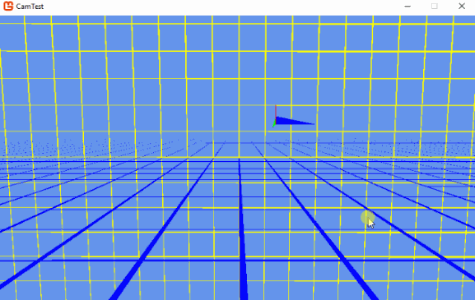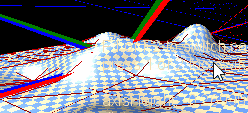// some grids and stuff to see get some bearings.
using Microsoft.Xna.Framework;
using Microsoft.Xna.Framework.Graphics;
using Microsoft.Xna.Framework.Input;
namespace CamTest
{
public class Grid3dOrientation
{
public Grid3d gridForward;
public Grid3d gridRight;
public Grid3d gridUp;
/// <summary>
/// Draws 3 3d grids, linewith should be very small like .001
/// </summary>
public Grid3dOrientation(int x, int y, float lineWidth)
{
gridForward = new Grid3d(x, y, lineWidth, true, 0);
gridRight = new Grid3d(x, y, lineWidth, true, 1);
gridUp = new Grid3d(x, y, lineWidth, true, 2);
}
/// <summary>
/// Draws this world grid with basic effect.
/// </summary>
public void DrawWithBasicEffect(GraphicsDevice gd, BasicEffect effect, Matrix world, float scale, Texture2D forwardTexture, Texture2D upTexture, Texture2D rightTexture)
{
// Draw a 3d full orientation grid
//gd.RasterizerState = new RasterizerState() { FillMode = FillMode.Solid, CullMode = CullMode.None };
effect.World = Matrix.CreateScale(scale) * world;
bool isLighting = effect.LightingEnabled;
effect.LightingEnabled = false;
effect.Texture = upTexture;
gridForward.DrawWithBasicEffect(gd, effect);
effect.Texture = forwardTexture;
gridRight.DrawWithBasicEffect(gd, effect);
effect.Texture = rightTexture;
gridUp.DrawWithBasicEffect(gd, effect);
if (isLighting)
effect.LightingEnabled = true;
}
/// <summary>
/// The method expects that the shader can accept a parameter named TextureA.
/// </summary>
public void Draw(GraphicsDevice gd, Effect effect, Texture2D forwardTexture, Texture2D upTexture, Texture2D rightTexture)
{
// Draw a 3d full orientation grid
gd.RasterizerState = new RasterizerState() { FillMode = FillMode.Solid, CullMode = CullMode.None };
effect.Parameters["TextureA"].SetValue(upTexture);
gridForward.Draw(gd, effect);
effect.Parameters["TextureA"].SetValue(forwardTexture);
gridRight.Draw(gd, effect);
effect.Parameters["TextureA"].SetValue(rightTexture);
gridUp.Draw(gd, effect);
}
public void Draw(GraphicsDevice gd, Effect effect, int part0to2)
{
if (part0to2 == 0)
{
gridForward.Draw(gd, effect);
}
else
{
if (part0to2 == 1)
gridRight.Draw(gd, effect);
else
gridUp.Draw(gd, effect);
}
}
}
public class Grid3d
{
int width;
int height;
public VertexPositionTexture[] vertices;
public int[] indices;
/// <summary>
/// Creates a grid for 3d modelspace.
/// The Width Height is doubled into negative and positive.
/// linesize should be a very small value less then 1;
/// flip options range from 0 to 2
/// </summary>
public Grid3d(int rows, int columns, float lineSize, bool centered, int flipOption)
{
rows *= 2;
columns *= 2;
Vector3 centerOffset = Vector3.Zero;
if (centered)
centerOffset = new Vector3(-.5f, -.5f, 0f);
width = rows;
height = columns;
int len = width * 4 + height * 4;
float xratio = 1f / width;
float yratio = 1f / height;
vertices = new VertexPositionTexture[len];
indices = new int[(width * 6 + height * 6) * 2];
int vIndex = 0;
int iIndex = 0;
for (int x = 0; x < width; x++)
{
int svIndex = vIndex;
Vector3 xpos = new Vector3(xratio * x, 0f, 0f);
vertices[vIndex] = new VertexPositionTexture(
new Vector3(0f, 0f, 0f) + xpos + centerOffset,
new Vector2(0f, 0f));
vIndex++;
vertices[vIndex] = new VertexPositionTexture(
new Vector3(0f, 1f, 0f) + xpos + centerOffset,
new Vector2(0f, 1f));
vIndex++;
vertices[vIndex] = new VertexPositionTexture(
new Vector3(lineSize, 0f, 0f) + xpos + centerOffset,
new Vector2(1f, 0f));
vIndex++;
vertices[vIndex] = new VertexPositionTexture(
new Vector3(lineSize, 1f, 0f) + xpos + centerOffset,
new Vector2(1f, 1f));
vIndex++;
// triangle 1
indices[iIndex + 0] = svIndex + 0; indices[iIndex + 1] = svIndex + 1; indices[iIndex + 2] = svIndex + 2;
// triangle 2
indices[iIndex + 3] = svIndex + 2; indices[iIndex + 4] = svIndex + 1; indices[iIndex + 5] = svIndex + 3;
// triangle 3 backface
indices[iIndex + 0] = svIndex + 2; indices[iIndex + 1] = svIndex + 1; indices[iIndex + 2] = svIndex + 0;
// triangle 4 backface
indices[iIndex + 3] = svIndex + 3; indices[iIndex + 4] = svIndex + 2; indices[iIndex + 5] = svIndex + 1;
iIndex += 6 * 2;
}
for (int y = 0; y < height; y++)
{
int svIndex = vIndex;
Vector3 ypos = new Vector3(0f, yratio * y, 0f);
vertices[vIndex] = new VertexPositionTexture(new Vector3(0f, 0f, 0f) + ypos + centerOffset, new Vector2(0f, 0f)); vIndex++;
vertices[vIndex] = new VertexPositionTexture(new Vector3(0f, lineSize, 0f) + ypos + centerOffset, new Vector2(0f, 1f)); vIndex++;
vertices[vIndex] = new VertexPositionTexture(new Vector3(1f, 0f, 0f) + ypos + centerOffset, new Vector2(1f, 0f)); vIndex++;
vertices[vIndex] = new VertexPositionTexture(new Vector3(1f, lineSize, 0f) + ypos + centerOffset, new Vector2(1f, 1f)); vIndex++;
// triangle 1
indices[iIndex + 0] = svIndex + 0; indices[iIndex + 1] = svIndex + 1; indices[iIndex + 2] = svIndex + 2;
// triangle 2
indices[iIndex + 3] = svIndex + 2; indices[iIndex + 4] = svIndex + 1; indices[iIndex + 5] = svIndex + 3;
// triangle 3 backface
indices[iIndex + 0] = svIndex + 2; indices[iIndex + 1] = svIndex + 1; indices[iIndex + 2] = svIndex + 0;
// triangle 4 backface
indices[iIndex + 3] = svIndex + 3; indices[iIndex + 4] = svIndex + 2; indices[iIndex + 5] = svIndex + 1;
iIndex += 6 * 2;
}
Flip(flipOption);
}
void Flip(int flipOption)
{
if (flipOption == 1)
{
int index = 0;
for (int x = 0; x < width; x++)
{
for (int i = 0; i < 4; i++)
{
var p = vertices[index].Position;
vertices[index].Position = new Vector3(0f, p.X, p.Y);
index++;
}
}
for (int y = 0; y < height; y++)
{
for (int i = 0; i < 4; i++)
{
var p = vertices[index].Position;
vertices[index].Position = new Vector3(0f, p.X, p.Y);
index++;
}
}
}
if (flipOption == 2)
{
int index = 0;
for (int x = 0; x < width; x++)
{
for (int i = 0; i < 4; i++)
{
var p = vertices[index].Position;
vertices[index].Position = new Vector3(p.Y, 0f, p.X);
index++;
}
}
for (int y = 0; y < height; y++)
{
for (int i = 0; i < 4; i++)
{
var p = vertices[index].Position;
vertices[index].Position = new Vector3(p.Y, 0f, p.X);
index++;
}
}
}
}
public void DrawWithBasicEffect(GraphicsDevice gd, BasicEffect effect)
{
effect.TextureEnabled = true;
effect.VertexColorEnabled = false;
foreach (EffectPass pass in effect.CurrentTechnique.Passes)
{
pass.Apply();
gd.DrawUserIndexedPrimitives(PrimitiveType.TriangleList, vertices, 0, vertices.Length, indices, 0, (indices.Length / 3), VertexPositionTexture.VertexDeclaration);
}
}
public void Draw(GraphicsDevice gd, Effect effect)
{
foreach (EffectPass pass in effect.CurrentTechnique.Passes)
{
pass.Apply();
gd.DrawUserIndexedPrimitives(PrimitiveType.TriangleList, vertices, 0, vertices.Length, indices, 0, (indices.Length / 3), VertexPositionTexture.VertexDeclaration);
}
}
}
public class OrientationLines
{
VertexPositionColor[] vertices;
int[] indices;
public OrientationLines()
{
CreateOrientationLines(.1f, 1.0f);
}
public OrientationLines(float linewidth, float lineDistance)
{
CreateOrientationLines(linewidth, lineDistance);
}
private void CreateOrientationLines(float linewidth, float lineDistance)
{
var center = new Vector3(0, 0, 0);
var scaledup = Vector3.Up * linewidth;
var scaledforward = Vector3.Forward * linewidth;
var forward = Vector3.Forward * lineDistance;
var right = Vector3.Right * lineDistance;
var up = Vector3.Up * lineDistance;
var r = new Color(1.0f, 0.0f, 0.0f, .8f);
var g = new Color(0.0f, 1.0f, 0.0f, .8f);
var b = new Color(0.0f, 0.0f, 1.0f, .8f);
vertices = new VertexPositionColor[9];
indices = new int[18];
// forward
vertices[0].Position = forward; vertices[0].Color = g;
vertices[1].Position = scaledup; vertices[1].Color = g;
vertices[2].Position = center; vertices[2].Color = g;
indices[0] = 0; indices[1] = 1; indices[2] = 2;
indices[3] = 0; indices[4] = 2; indices[5] = 1;
// right
vertices[3].Position = right; vertices[3].Color = b;
vertices[4].Position = scaledup; vertices[4].Color = b;
vertices[5].Position = center; vertices[5].Color = b;
indices[6] = 3; indices[7] = 4; indices[8] = 5;
indices[9] = 3; indices[10] = 5; indices[11] = 4;
// up square
vertices[6].Position = up; vertices[6].Color = r;
vertices[7].Position = center; vertices[7].Color = r;
vertices[8].Position = scaledforward; vertices[8].Color = r;
indices[12] = 6; indices[13] = 7; indices[14] = 8;
indices[15] = 6; indices[16] = 8; indices[17] = 7;
}
public void DrawWithBasicEffect(GraphicsDevice gd, BasicEffect effect, Matrix world)
{
effect.World = world;
effect.VertexColorEnabled = true;
effect.TextureEnabled = false;
foreach (EffectPass pass in effect.CurrentTechnique.Passes)
{
pass.Apply();
gd.DrawUserIndexedPrimitives(PrimitiveType.TriangleList, vertices, 0, vertices.Length, indices, 0, (indices.Length / 3), VertexPositionColor.VertexDeclaration);
}
}
public void DrawWithBasicEffect(GraphicsDevice gd, BasicEffect effect)
{
effect.VertexColorEnabled = true;
effect.TextureEnabled = false;
foreach (EffectPass pass in effect.CurrentTechnique.Passes)
{
pass.Apply();
gd.DrawUserIndexedPrimitives(PrimitiveType.TriangleList, vertices, 0, vertices.Length, indices, 0, (indices.Length / 3), VertexPositionColor.VertexDeclaration);
}
}
public void Draw(GraphicsDevice gd, Effect effect)
{
foreach (EffectPass pass in effect.CurrentTechnique.Passes)
{
pass.Apply();
gd.DrawUserIndexedPrimitives(PrimitiveType.TriangleList, vertices, 0, vertices.Length, indices, 0, (indices.Length / 3), VertexPositionColor.VertexDeclaration);
}
}
}
}
One last note i probably should of called recreateViewMatrix in all those function calls for just repositioning i,e, move up down left right ect… not just on the rotate functions. You can add it in though its just the one liner.
Merry Christmas

